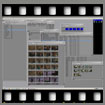 Here is a concise guide to selecting the proper double-system audio and timecode settings for your digital audio recorder, when recording sync sound for SD video, HD video, and film projects that will be imported into MC5.
Here is a concise guide to selecting the proper double-system audio and timecode settings for your digital audio recorder, when recording sync sound for SD video, HD video, and film projects that will be imported into MC5.
These are very confusing issues for the newcomer as well as for us seasoned veterans. When I began my research to find what I considered simple answers to simple questions, I was shocked that even many of the industry experts had to think carefully about the answers.... for not only has the technology of film and video production crossed each others lines, but changes have come about in the world of Avid and the way we deal with these myriad files.
For example, video likes to confuse film folk with terms like 24fps and 30fps, when in reality they are trying to say 23.976 or 29.97 frames per second (video). Then there are the 2:3 pullups that are added to the 23.976 frames to bring them up to the 29.97 video standard that television sets and VTR's demanded. So it makes a lot of difference to editors whether or not we are shooting for video release in 29.97, 23.976 HD, or returning to sprocketed film. And whether or not our editing software can handle actual 24 frame footage, or fakes it in a 29.97 virtual world!
That's why there are no windows in edit bays.... otherwise there would be an awful lot of bodies on the sidewalks below.
The location Sound Mixer has to choose what bit rate and sampling rate to use, and what the proper timecode settings need to be. This guide skips over the theory, but presents the latest consensus on what settings are preferred, based on the capabilities of Media Composer verson 5, that was just released this summer (June 2010). As of November 2010, these settings are recommended practice.
However, whenever opportunity presents, you should always confer with someone high up in the Post Production chain to confirm. The world is changing, sometimes faster than we can keep track of.
For example, just a couple years ago, it was standard practice to use 29.97 timecode for all video projects, be they 29.97 SD or 23.976 HD. Today, the latest digital recorders give us the option of using 23.976 timecode, and the lastest editing software prefers it.
![]() Special thanks to: Joe Schwartz (Calif State Univ Northridge, CTVA Dept), Sam Kauffmann (Boston Univ, author of Avid Editing), Charles Parra (Denecke Inc.), and Mike Paul (Location Sound Corp) for their consultations on this matter.
Special thanks to: Joe Schwartz (Calif State Univ Northridge, CTVA Dept), Sam Kauffmann (Boston Univ, author of Avid Editing), Charles Parra (Denecke Inc.), and Mike Paul (Location Sound Corp) for their consultations on this matter.
|
Picture Format |
Avid Project Type |
Location Audio |
Audio Timecode |
Notes |
|
29.97 SD |
30i NTSC |
16bit 48k .BWF* |
29.97 ndf |
No pulldown of audio required. |
|
24bit 48k .BWF |
29.97 ndf |
No pulldown of audio required. |
||
|
16bit 48k .WAV |
Non-timecode recorder |
No pulldown of audio. Avid can autosync audio w/o TC by marking IN points at head slates or OUT points at tail slates of video and audio clips. |
||
|
23.976 HD video |
1080p/23.976 |
16bit 48k .BWF* |
23.976 timecode |
Pulldown of audio not possible. |
|
24bit 48k .BWF |
23.976 timecode |
Pulldown of audio not possible. Check with postproduction before using 24 bit. |
||
|
16bit 48k .WAV |
Non-timecode recorder |
Pulldown of audio not possible. |
||
|
Film 24fps |
24p NTSC |
16bit 48k .BWF* |
30.00 ndf timecode |
Avid can pulldown audio to match picture speed; set Avid Audio Source Tape TC Rate to 30.00 fps. |
|
24bit 48k .BWF |
30.00 ndf timecode |
Avid can pulldown audio to match picture speed; set Avid Audio Source Tape TC Rate to 30.00 fps. Check with postproduction about using 24 bit. |
||
|
16bit 48k .WAV |
Non-timecode recorder |
Avid can pulldown audio to match picture speed |
||
|
16bit 48.048k .BWF |
30.00 ndf timecode |
Although recorded at 48.048, files are stamped by recorder as only 48.000, so Avid plays them back at 0.1% slower, same as if they had been pulled down. Make sure that audio checkbox is DO NOT CONVERT or else you will pulldown the original file twice! |
||
|
24bit 48.048k .BWF |
30.00 ndf timecode |
|||
